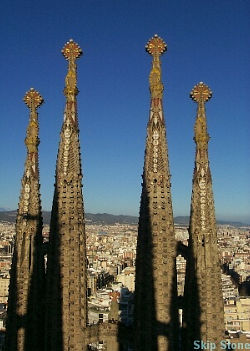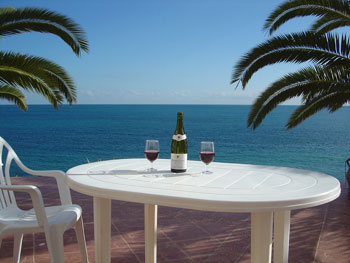We love Spain so much we created this short video to share a bit with you about the many wonders to be found there.
Travel along with the Hip Guide to Spain and visit Barcelona, Calpe, Moraira and more!

We love Spain so much we created this short video to share a bit with you about the many wonders to be found there.
Travel along with the Hip Guide to Spain and visit Barcelona, Calpe, Moraira and more!
These are my favorite Spanish wines, from the Utiel-Requenna area northwest of Valencia. Smooth, deep, and delicious, they produce reds, whites and rosés.
Founded in 1885 by Vicente Gandia Pla, the more than 100 years of experience as a family-run winery shows in the beautiful wines they make.
According to their publicity, “the passion, effort and care that we put into making high-quality wines are the result of knowledge passed down from father to son for four generations.”
Thanks to this spirit of constant growth and renewal, Bodegas Gandía is one of the leading Spanish producers of bottled wine, doing business in more than 75 countries on four continents.
With more than 200 hectares at the Hoya de Cadenas estate and other facilities in Valencia, the firm employs more than 100 professional winemakers. All of their wines are aged in American oak casks for that special flavor.
The grapes they produce and make into wines are Chardonnay, Cabernet Sauvignon, Sauvignon Blanc, Merlot, Tempranillo and Bobal. I can attest to the fineness of the Tempranillo from drinking many, many bottles of this wine during the winter of 2004-2005 while staying on the Costa Blanca. The wines produced during the year 2003 are exceptionally fine, and two years later are quite drinkable, and enjoyable, indeed. Good thing it was a majorly prolific year for the grape harvest in Spain, in 2003. They say global warming is only making the European wines better and better. Small consolation I suppose.
So when in Spain, be sure to visit Valencia for the Feria, some Paella, and then venture into the mountains to the cool heights of Utiel-Requenna, and visit the Hoya de Cadenas estate of the Gandia family winery. You won’t forget it. And I guarantee you’ll enjoy the wine.
Info:
From Valencia drive northwest to Utiel, then on to Los Coralles. From here continue to the town of Las Cueva, and you can find signs to the Finca Hoya de Cadenas from here. It takes about one and a half hours to get here from Valencia.
La Semilla “the seed” is a little hippy haven tucked away in stunning mountains on the coast of Andalucia, with views to Morocco. It is a cultural association hosting several music/art workshops throughout the year, as well as being open at weekends in the summer as a vegetarian and organic restaurant. Prices are moderate, but if you love quality vegetarian food you may just find the meal and the views over the mountains and ocean to Morocco an overwhelmingly wonderful experience.
A visit to the famed La Sagrada Familia in Barcelona, Spain. This is considered to be Anotonio Gaudi’s unfinished masterpiece, a grand cathedral still under construction. This is truly one of the most wonderful pieces of architecture I have ever visited.
Visit Barcelona’s Las Ramblas and enjoy some of the colorful street entertainers that line the walkway to the sea.

People will finally be able to worship in La Sagrada Familia, Antonio Gaudi’s beautiful church in Barcelona, after the Pope dedicates it this Sunday. The church has been under construction for 128 years, and will require many more years before completion.
Lanzarote – the eastern most Canary Island – is home to some of the most unusual real estate on the planet. Thanks to a cataclysmic volcanic eruption – which lasted six years from 1730. Which covered one quarter of the island in solidified lava – so forcing a serious re-think about how to construct homes and houses.
This unique architectural approach is today best epitomized by the incredible home of the island born artist and architect Cesar Manrique – owner of what is undoubtedly the most famous and surreal property in Lanzarote.
Back in the 1960´s Manrique created a house within a series of five volcanic bubbles, which still blows visitors away to this day. This ingenious feat of architecture was Manrique´s first major piece of work on Lanzarote and encapsulates his organic approach and desire to create a perfect symbiosis between man, art and nature.
In the early 1960´s Manrique was studying art in New York and rubbing shoulders with the likes of Andy Warhol. But as tourism started to take off back on his native island he felt the urge to return. Afraid that his beloved Lanzarote could be buried beneath a sea of four star hotels and apartments. As had happened in other Spanish sun spots.
Manrique discovered his site by walking the lava fields that surround much of Tahiche. A small village, which is centrally located on Lanzarote. Here, the green tip of a fig tree caught his eye growing just above the sea of black volcanic rock. And on closer inspection he found that this emerged from one of five large bubbles that had been created within the flow.
Work commenced, the five underground chambers were interconnected, and by the end of 1968 Manrique´s creation was complete. Providing him with the perfect work and exhibition space and Lanzarote with a blueprint for future development.

If you’d like to visit Spain, but don’t want to stay in hotels or apartments, you should consider renting a villa. If you’re going to stay in one place for a week or more, we highly recommend Spanish villas because they provide a more unique experience and can usually save you a lot of money, especially in the off-season. It’s also a good idea if you’re looking to buy property in Spain to rent a villa in the area you’re considering first, to see what it would be like living there.
Most rental villas are located along the beautiful Spanish coast, and usually have stunning seaviews, a swimming pool, lots more room than apartments, and normally can accommodate six or more persons. While there are some older style villas available, more and more villas are relatively new or have been recently remodeled. This means a modern kitchen with a big refrigerator, and sometimes a dishwasher. All villas have a washing machine, but few have dryers as drying your clothes outdoors is one Spanish tradition that’s hard to change.
Banking in Spain for Tourists and Long-Term Ex-Pats
Visiting your local bank in Spain has become painless indeed since Franco died. Now in the year 2005, there is at least one English-speaking ‘bank officer’ on hand in just about any branch in southern Spain. They like showing off their mastery languages as they open ‘tourist’ accounts with glee.
An added bonus for us technology worshipping ex-pats is that most of their websites are also in several languages for ease of use.
Here is an almost complete list of banks in Spain, including the website addresses for each:
First service station with biodiesel in Spain
CIVITAS2004-Sustainable Development News
02/27/03
TÀRREGA, Lleida, February 25, 2003 – A service station in the town of Tàrrega, in the Lleida region, has opened the first pump in Spain that supplies biodiesel, which is partly made up of vegetable-based oils. This fuel pollutes less, reduces noise and prolongs the life of the engine because lubrication is improved.
The biofuel, sold under the name of BDP 30 in the Petromiralles service station at the national N-11 motorway exit at the municipal limit of Tàrrega, is a blend of 30% vegetable-based oils and 70% diesel and is biodegradable and 30% less polluting than traditional diesel.
This ecological fuel is sold at the same price as conventional diesel and can be used in all vehicles that run on diesel. It is produced by the manufacturing plant Stocks del Vallés in collaboration with the Catalan Energy Institute of the Generalitat (Regional Government) of Catalonia. The Catalan government envisages that, by 2010, 8% of all diesel consumed in Catalonia will be bio-diesel, in keeping with the European norms on fuel consumption.
The distributing company, Petromiralles, is to install another five pumps with the same type of fuel in the towns of Figueres, Igualada, Vilafranca del Penedès, Cercs and the port area of Barcelona.